Store-Bought Vegetables that Can Be Regrown to Save Money
This post may contain affiliate links. Read our disclosure policy here.
Unlock the secret to endless greens with vegetables that can be regrown from scraps you already have! It’s the ultimate hack for fresh produce and stretching your dollar further.
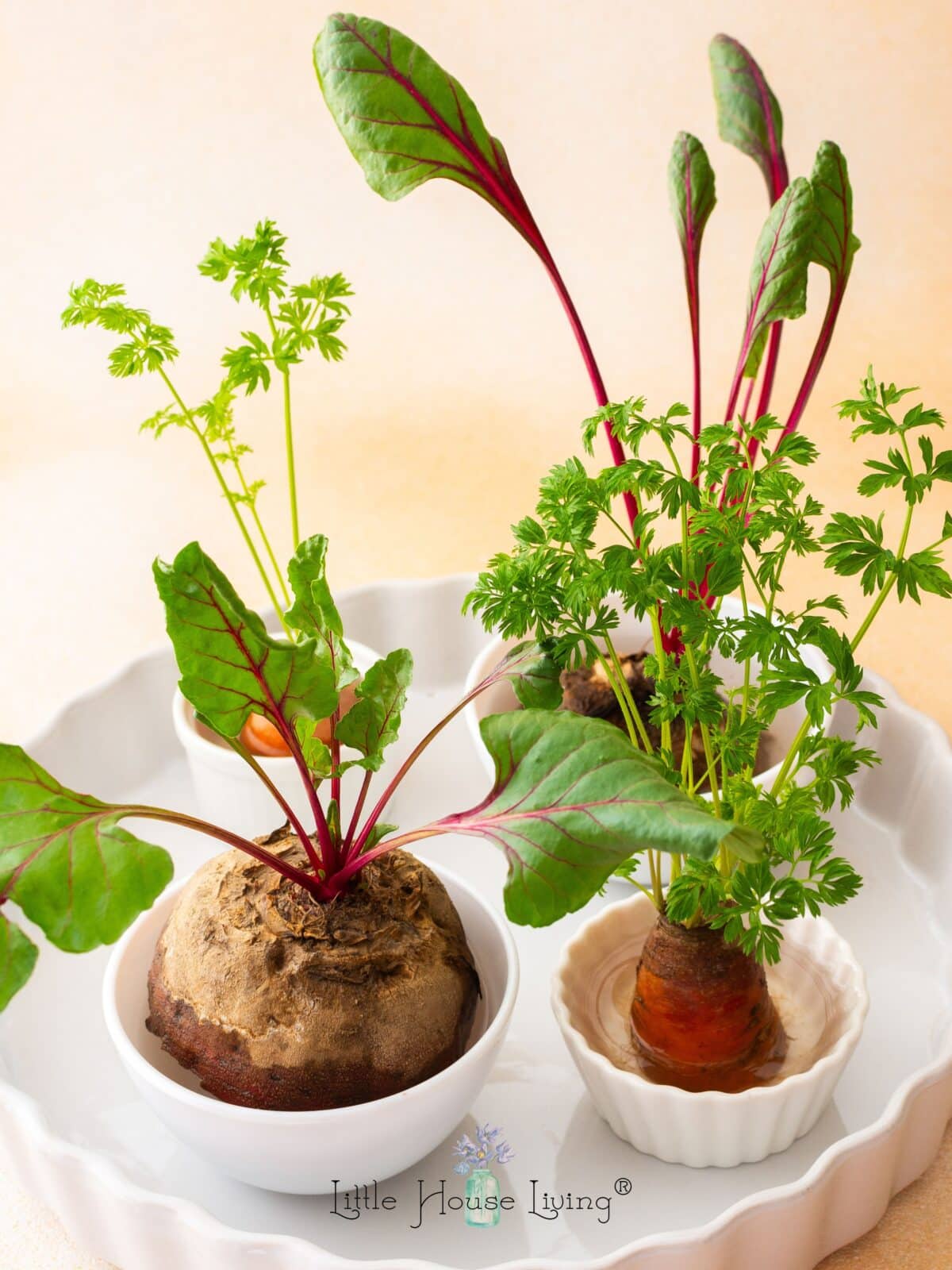
Veggies You Can Regrow From Scraps
I’m always looking for ways to save money on our groceries. Produce is typically what takes up so much of our grocery bill, so trying to stretch that budget out can sometimes be a challenge. I do try to purchase local produce as often as I can, but sometimes, going to the store is the only option.
One of the best ways I’ve found to save money on produce is to grow veggies from the store bought scraps! With just a little water and sunlight, you’d be surprised how quickly you can grow your own fruits, veggies, and herbs indoors.
Looking to cut down your grocery budget? Here are 12 Simple Ways to Save Money on Groceries
Even if you don’t have room for a full garden outdoors, you can usually find a nice windowsill or another bright area in your house that will be perfect for getting these started so that you can enjoy them again and again.
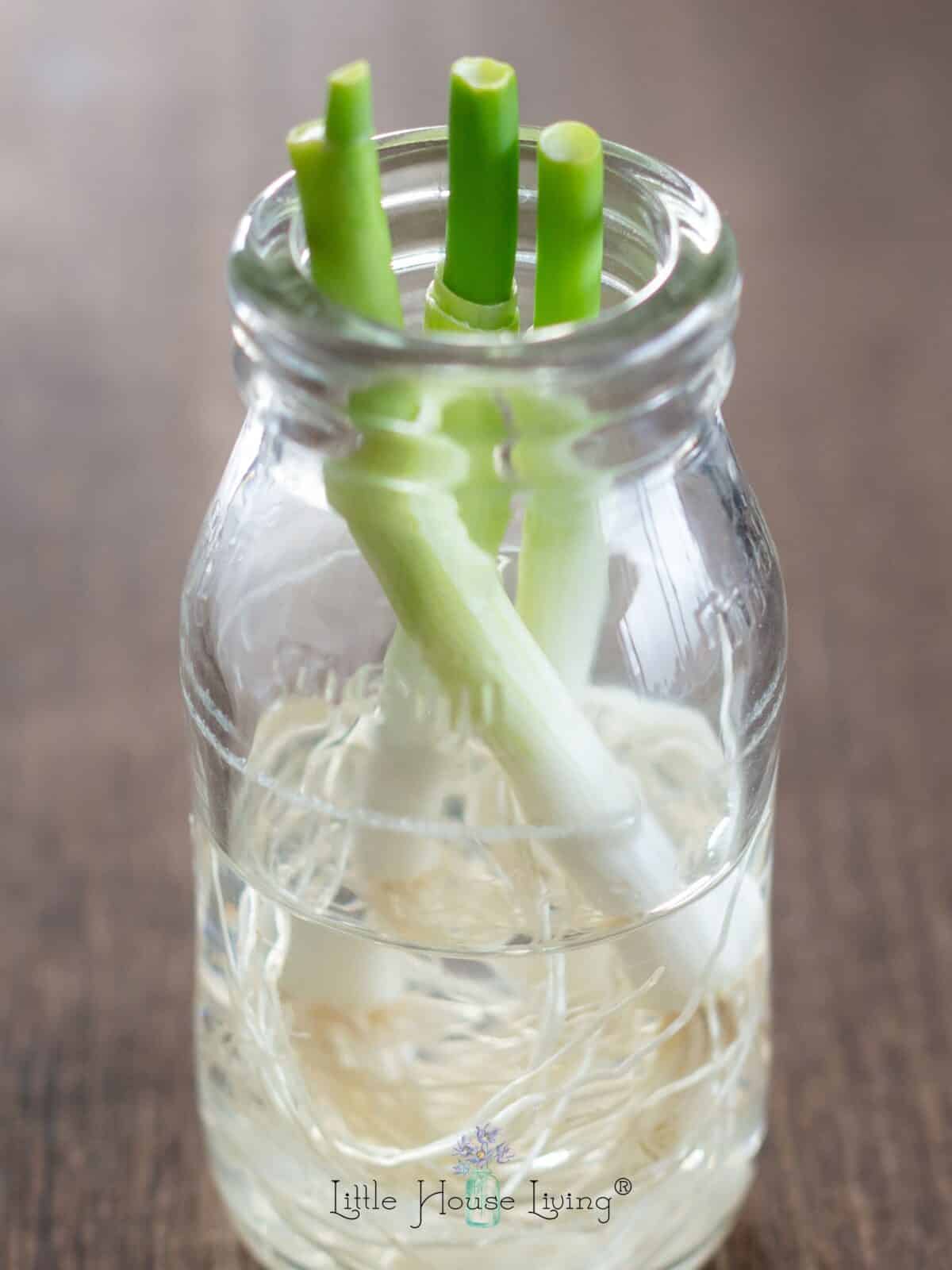
How to Regrow Veggies from Scraps
Regrowing Green Onions
Green onions are great to try as your first experiment as they are so easy to grow and require very little work.
Cut your green onion so that you have at least 1-2 inches of the white bulb, and place the bulb in a shallow cup of water. After just a few days, you’ll have fresh green onions. Chop off what you need, and they will continue to grow back again and again. All you need to do is keep them in a well-lit area and change out the water every few days. Leeks, scallions, fennel, and lemongrass can also be regrown, just like green onions.
I grow all of these indoors. My onions have lasted forever with weekly trimmings to garnish meals. I blanch my bok Choy, celery and leeks by adding dirt to the pots as they grow. I also have pineapple, but that’s more of an experiment for the kids because it will take years to fruit. We’ve gotten a half dozen new pineapple leaves in the last six months; it is grown near the heater and gets plenty of water. I also keep an herb garden on the hearth of my fireplace, where it gets ample sunlight. You can also cut of the bottom of regular onion and place the roots in water for a week. Replant it in dirt and onions will grow.
Saobin, Little House Living reader
Regrowing Celery
Celery takes a little more patience but grows just as well as green onions. To regrow celery, chop the stalks off and place the end nub, cut side up, into a shallow bowl of water. Change out the water every few days to keep it fresh, and spritz the new growth that begins to grow from the top with water daily. Continually cover the bottom with dirt as it grows to keep it from becoming bitter.
Your celery plant will take a while to grow big stalks, but you’ll have leaves in just a few days. Celery leaves are great for adding a little extra flavor to dishes, use as a garnish, or you can even make fresh pesto with them.
I tried re-growing celery. Didn’t work very well. It was really bitter. Turns out celery has to be blanched (repeated covering with dirt) while growing to prevent it from getting bitter.
Wendy, Little House Living reader
Regrowing Bok Choy
Bok Choy can be regrown just like celery. Both Celery and Bok Choy can be planted in the soil after they begin to grow roots and leaves, at just about 7-10 days.
Regrowing Carrots
While the carrot itself cannot be regrown, you can use your carrot top scraps to regrow more carrot tops. Simply cut the top off of the carrot and place it in a shallow dish of water in an area that gets good sunlight. The green carrot top will begin growing in just a few days. Carrot tops are full of nutrients and make a great addition to stock, salad, soup, or pesto.
Tip: Want to make your own chicken stock? Learn how in this post about Cooking a Whole Chicken Easily and What to Do With It.
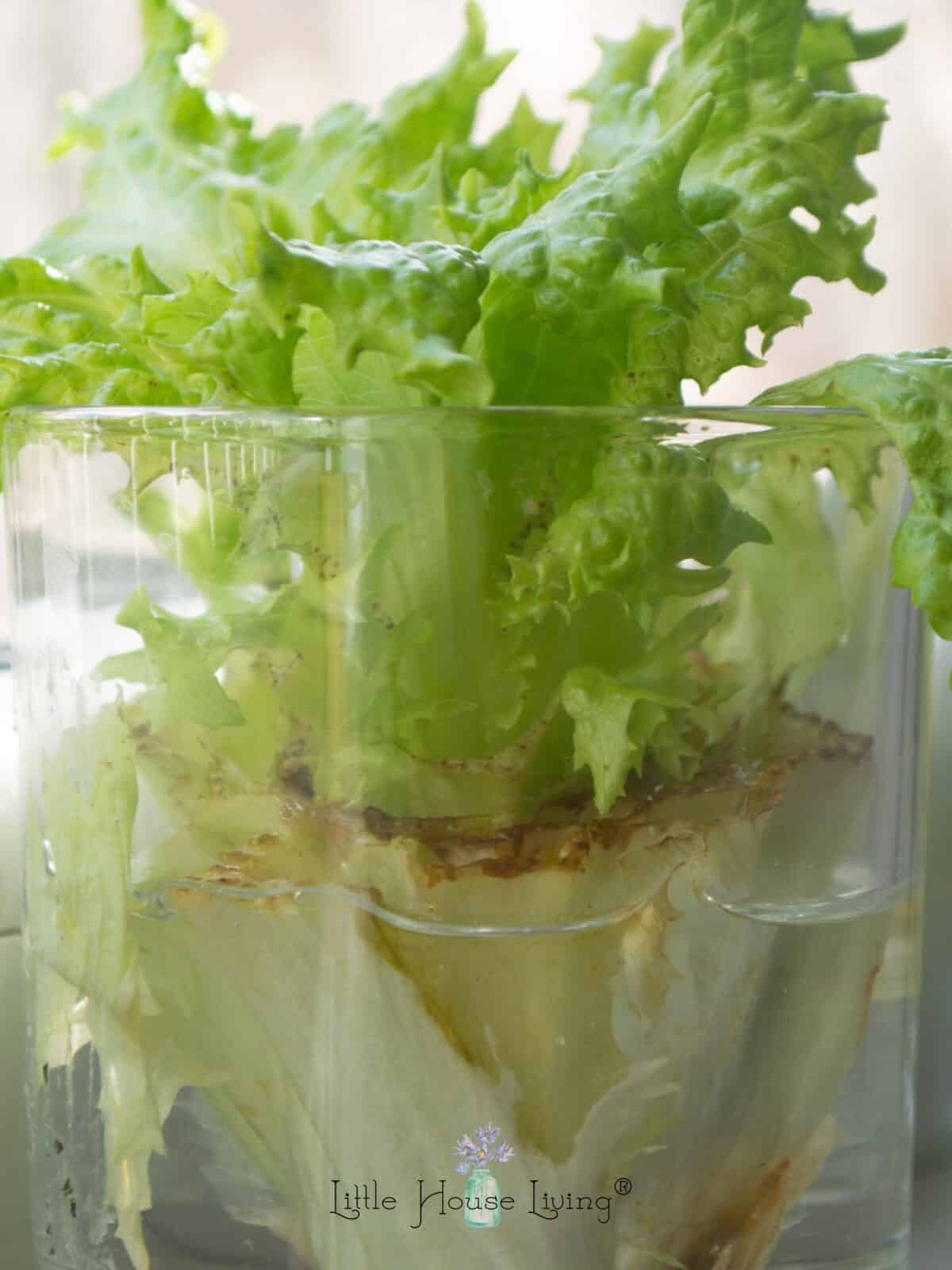
Regrowing Romaine Lettuce
Stretch your head of romaine by chopping off the leaves and leaving at least 1 inch at the base of the head of lettuce. Place the base into a shallow dish of water in sunlight. New leaves will begin to grow in just a few days. Once roots have formed, you can plant in the dirt or continue to grow in water, making sure to change it out every few days to keep it fresh.
Romaine lettuce works great. I have one growing now that needs to be potted or planted in the garden for a few more weeks of growth, hopefully it won’t snow for a while. I did find that organic romaine grows, regular will not. I’m not sure if they spray it with something or what, but it just rots in the water. Leave 2 inches of the end and I trim a very thin bit off the root end and place in a shallow bowl in non direct light.
Kay, Little House Living reader
Regrowing Garlic
You can regrow an entire bulb of garlic from just one clove. Place a clove of garlic, root side down, into a pot and cover with water. Keep it in a sunny spot and keep it well-watered. Your garlic will begin to grow shoots in just a few weeks.
Your garlic will be ready to harvest after it flowers and the leaves begin to die back, around 9 months. After your plant is well established, you can cut the tops of the plant off 6 inches above the dirt so the plant focuses on the bulb to speed up this process.
I put some store bought garlic cloves in the fridge and leave them there until they start to sprout then plant them. I put them in pots outside for the winter (Wisconsin winters!) and they start to grow first thing in the spring. The first year they grow they only get to about pearl onion size but if you pull them out of the ground, let them dry over the summer, and replant them the next year for the winter they get bigger. They are very easy to grow. If you don’t want to wait so long you can snip off the leaves and use them in things that don’t need a lot of cooking (like an omelette or a chip dip) and pull up the entire plant at the end of summer to use.
Mea, Little House Living reader
Regrowing Shallots
Shallots can be regrown like garlic but should only take about 2-4 months to harvest.
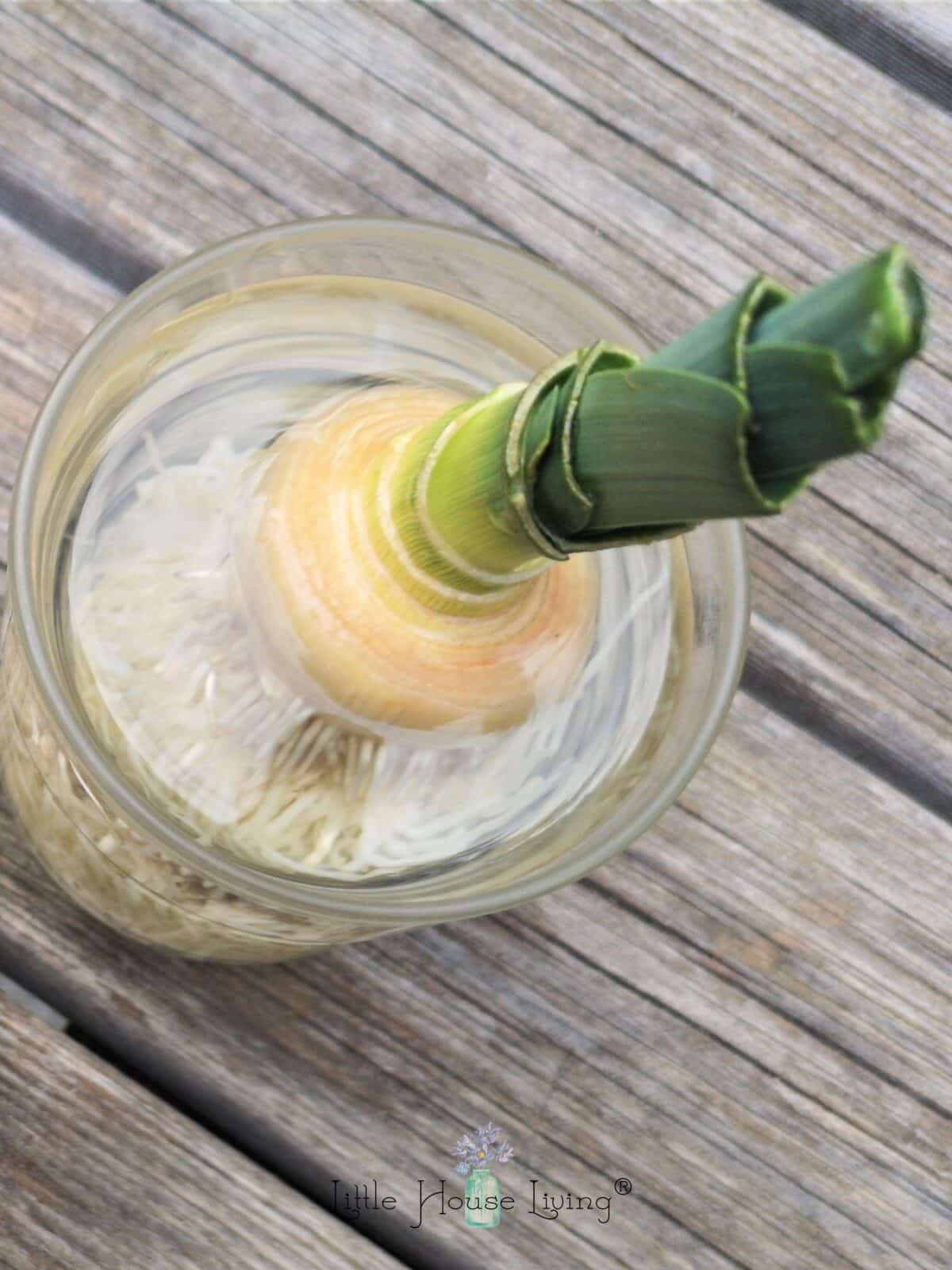
Regrowing Onions and Leeks
Onion can be regrown similarly to garlic and shallots, just cut the onion in half and place the root end in a pot. Cover with soil, place it in a sunny spot, and keep it watered when needed. Your new onions should be ready to harvest in 4-5 months.
Regrowing Ginger
To regrow ginger, pick a nice piece that has a few eyebuds. It’s best to use a nice, firm piece and not one that is dry or shriveled up. Soak the eye buds in warm water and then place them in a pot. Cover the eyes up with 1-2 inches of soil and spritz daily to keep moistened. Your ginger plant will begin to put offshoots in several weeks and will be ready to harvest in 3-4 months.
Regrowing Sweet Potatoes
To regrow sweet potatoes or to grow slips that you can plant from them, just place the potato in a jar of water. Use toothpicks to keep one-half of the potato above water. Your sweet potato will begin to grow roots on the bottom and leaves on the top.
When your sprouts up top are about 4-5 inches long, pull them off and place them in a jar until they begin to grow roots. (You can leave your sweet potato in the jar, and it will continue to put off more sprouts; just change the water every few days to keep it fresh) Once the sprouts are well rooted, plant them outside.
Regrowing Potatoes
Regular potatoes are a little easier than sweet potatoes; all you need is a potato with a few eyes on it. If you’re like me, you probably already have one on top of your fridge. Cut the potato into pieces so that each piece has 2-3 eyes on it. Allow the potato section to dry out for a few days, and then plant it in the ground.
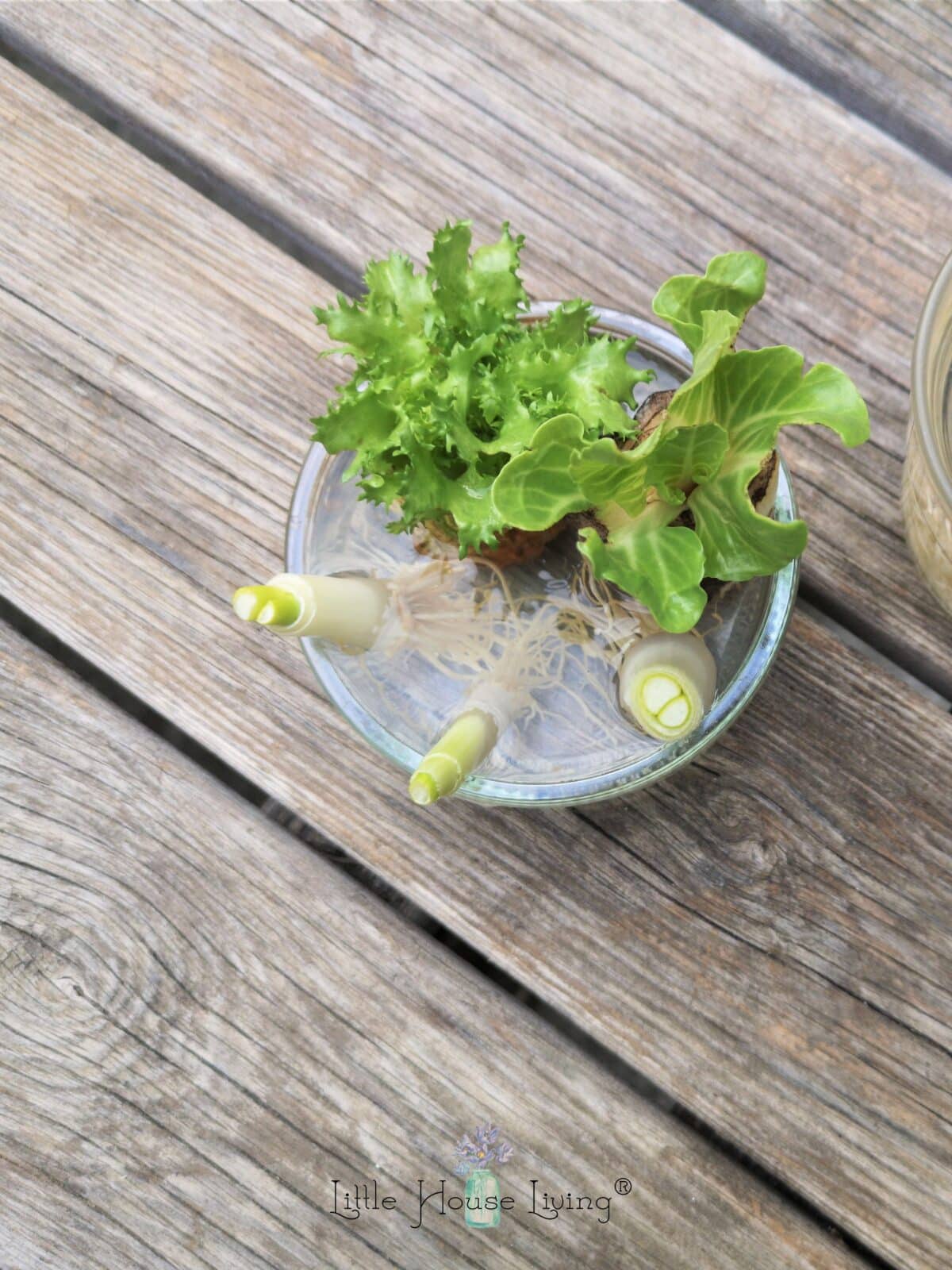
Regrowing Pineapple
Pineapple is pretty simple to grow as well, but it takes quite a bit of time and a humid environment. This would be a good one to try if you have a sunroom that stays warm year-round. Twist off the top of the pineapple, remove the bottom rows of leaves, and place the leaves into water. Roots will begin to grow from the bottom.
When they are 2-3 inches long, you can transplant them into well-drained soil. The pineapple plant will make a beautiful addition to your space; however, don’t expect any fruit for years.
growing pineapple from cut off top works…I have done it 3 times
Ronda, Little House Living reader
Regrowing Herbs
You can re-grow herbs such as Parsley, Basil, Cilantro, Dill, Mint, and more. Take a long stem of the herb and remove the bottom leaves, leaving a few on top. Place the stem in water so that all the areas where you removed the leaves is covered with water.
Roots will begin to sprout in a few days to a week. Transplant the plant into the soil once the roots get 2-3 inches long. Make sure to change out your water every few days to keep it clean.
Regrowing Aloe
This isn’t exactly a veggie, but it’s so easy to grow I wanted to include it. To regrow aloe, cut a 2-inch section of leaf and plant in soil. Keep it well watered, and it will begin to root and regrow leaves on top.
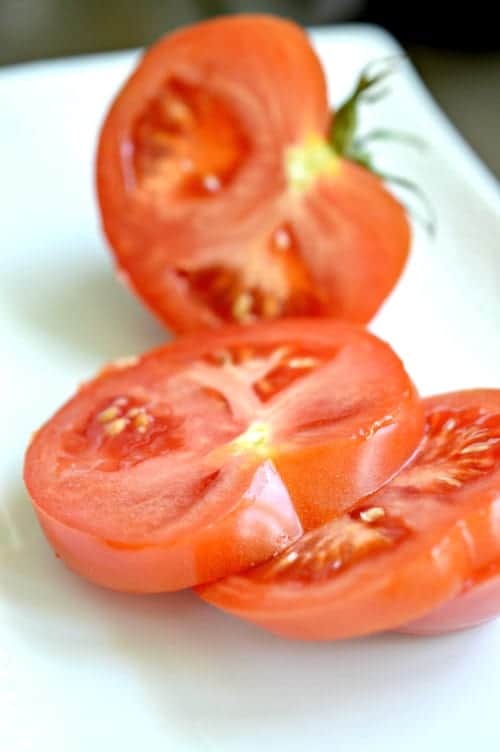
How to Regrow Vegetables from Seeds
These plants can be easily regrown with seeds from store-bought produce. For best results, use organic vegetables.
Also, to note, sometimes, when you buy tomatoes or other produce in the store, they are a hybrid breed. A cross between two types of tomato plants mixed to give you the best of both. Sometimes, that means a sweeter tomato mixed with a larger tomato; other times, they cross them for more favorable growing conditions- such as shorter plants or heartier plants. When you regrow plants from a hybrid seed, you won’t be growing the exact plant. Your new plant will be one of the two originals. They should still make great plants. I’ve done this many times with tomatoes and always had great results.
Regrow Tomatoes from the Store
Tomatoes are very easy to regrow. Simply save a slice of tomato and plant in under 1-2 inches of soil. Keep it watered and in a warm, sunny place and you’ll begin growing your own tomato plants in no time! (As your tomato plant grows larger, you can cut suckers that are at least 3-4 inches long off your plant and plant them to have even more tomato plants!)
Regrow Bell Peppers from the Store
Cut your bell pepper in half and knock the seeds loose into the bottom of the pepper. Plant the entire half of the pepper. Seeds will begin to sprout, and the pepper will break down and be a fertilizer for your new plants.
Regrow Melons from the Store
Watermelons can be easily regrown by harvesting the seeds out of your store-bought melon. For best germination, place the seeds in between two paper towels and spray with water. Keep moist for 4-5 days until the seed has softened. Plant the seed outside in a warm climate with plenty of sunlight.
Regrow Avocadoes from the Store
Avocados can be a fun project for you and the kids but probably not the best option for regrowing as they can take several years to get large enough to fruit. However, if you live in a warm climate and want to give it a go, all you need to do is place a few toothpicks into the middle of the seed and set it in a jar so that the bottom of the seed is underwater.
In about a month, you should have some roots growing. Plant the roots under the soil, leaving the top of the seed and sticking out. Keep it in a sunny place, well-watered and warm. As your plant gets larger, you can move it outdoors.
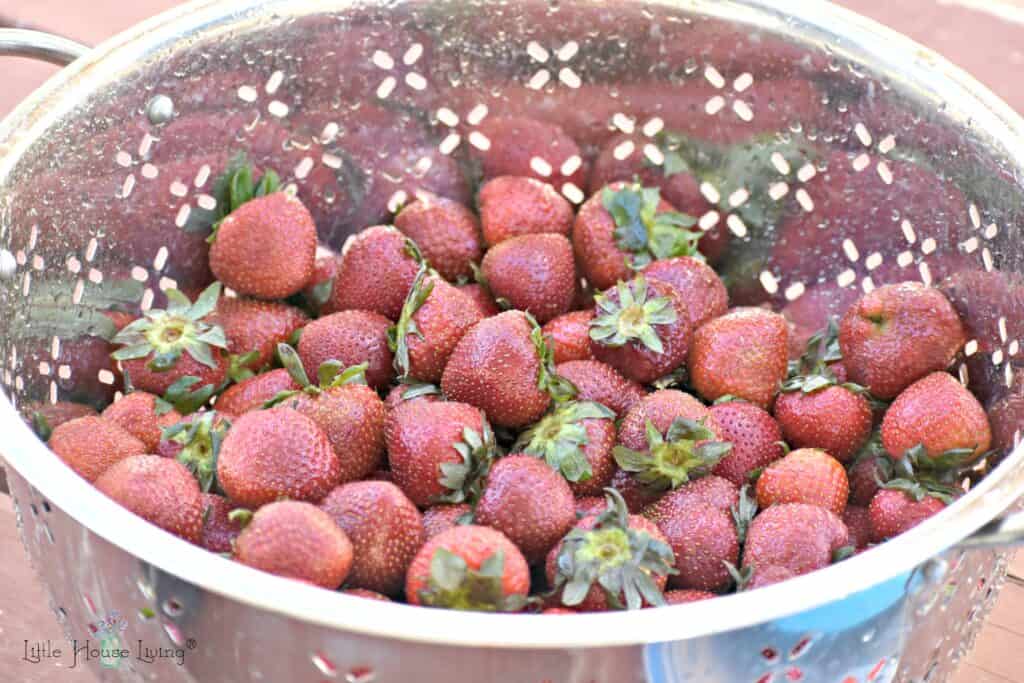
Other Fruits and Vegetables that Can Be Regrown From Seed
Lots of other fruits and vegetables can be regrown by seed, too, if you live in a warm climate. Pumpkin, Lemon, Cucumbers, Strawberries, Peaches, and more. All you need to do is plant the seeds in warm soil and keep them watered until they are ready to harvest
Tip: Learn more about How to Save Seeds from the fruit and vegetables you’ve grown or purchased.
This newfound love of re-growing vegetables indoors is seriously addicting. I love knowing I can save a few dollars each trip by ‘re-using” what I already have!
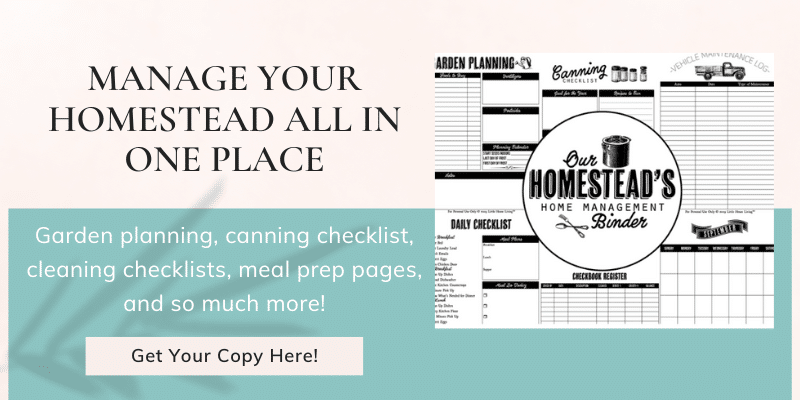
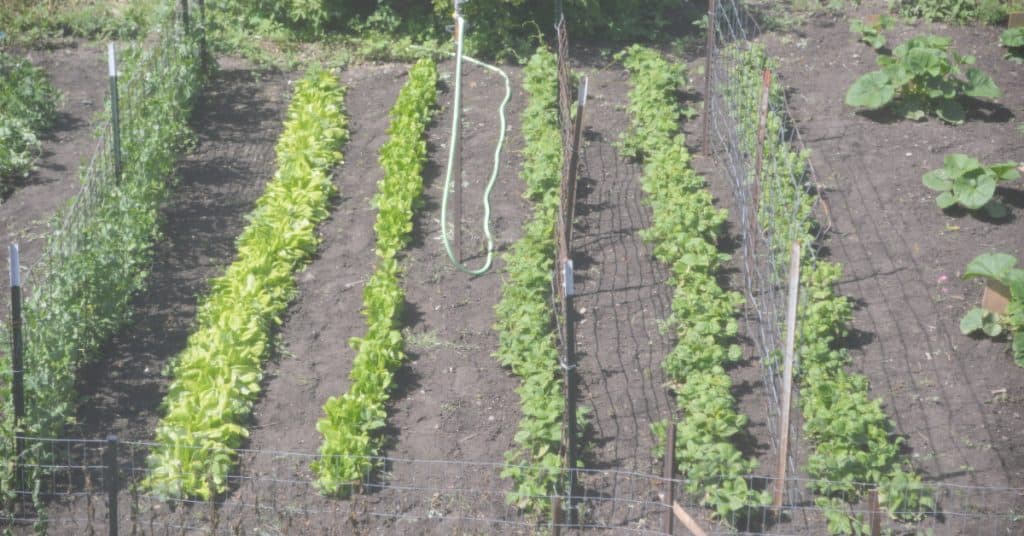
More Gardening Tips & Tricks
- Planning Out and Growing Your Perfect Garden
- 14 Simple Gardening Tips for Any Size Garden
- Small Vegetable Garden Ideas ~ Gardening in Small Spaces
- Starting Garden Plants From Seed; Growing Your Own Plant Starts
- The Gardening and Preserving Journal
Have you ever re-grown any veggies or fruits? Which ones?

Merissa Alink
Merissa has been blogging about and living the simple and frugal life on Little House Living since 2009 and has internationally published 2 books on the topic. You can read about Merissa’s journey from penniless to freedom on the About Page. You can send her a message any time from the Contact Page.
This post on Vegetables that Can Be Regrown was originally published on Little House Living in February 2013. It has been updated as of February 2024.

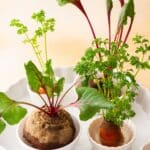

Pineapple?! WOW – this I have to try!
I know right? It’s pretty crazy!
Pineapple makes a pretty plant and in time it will make a fruit. Protect it in the winter or it will freeze. Lost mine this year. but it was pretty .
growing pineapple from cut off top work…I have done it 3 times
Really? Good to know it works well!
I tried pineapple once and it didn’t work. I threw it away feeling disappointed. So, what could be the problem?
I tried re-growing celery. Didn’t work very well. It was really bitter. Turns out celery has to be blanched (repeated covering with dirt) while growing to prevent it from getting bitter.
I hadn’t heard about that. Thanks for sharing!
Wendy,
Celery contains a couple of natural toxins. see http://healthyeating.sfgate.com/celery-toxic-6720.html
It is probably best to blanch the celery, and use it as part of a diet with a wide range of fruits and vegetables.
Celery should be covered around the sides so it doesn’t get too much light. That will help keep it pale colored and better tasting. Only the tops need plenty of light. But be sure it gets enough air that it doesn’t mold inside the covering.
I am trying romaine lettuce right now. I saw it on pinterest and was a little curious. Great post!
I’d love to know how it goes!
I tried Romaine and didn’t protect it and the squirrels ate it LOL
Got to try again soon.
I subscribe to your blog via email, I saw this article and was very excited to learn this. I live in a highrise, can’t wait to give it a go, thanks so much!
Ahhh! This would be perfect for you! Let us know how your adventure goes!
You mentioned pineapple needs to be done in warmer climates. I thought all of these were done inside, so I am unclear why it matters where you live. I am reading this right, or are these meant to be put outside?
Sorry, I should have been more clear! The ones where you put in soil, you can also put outside. With the pineapple, if planting outside, it would be best to be in a climate that doesn’t get too cold.
I have a question please… If I cut the onions all the way to the white bulb leaving maybe 1/4 left with the roots, will this work? and what will grow out of that green or white again? Just wondering…thanks so much for yor site!
Rose
They will be green! Sounds crazy I know, but it seriously works! The picture above is my set that had been clipped about 3-4 times already!
I grow all of these indoors. My onions have lasted forever with weekly trimmings to garnish meals. I blanch my bok Choy, celery and leeks by adding dirt to the pots as they grow. I also have pineapple, but that’s more of an experiment for the kids because it will take years to fruit. We’ve gotten a half dozen new pineapple leaves in the last six months; it is grown near the heater and gets plenty of water. I also keep an herb garden on the hearth of my fireplace, where it gets ample sunlight. You can also cut of the bottom of regular onion and place the roots in water for a week. Replant it in dirt and onions will grow.
fun stuff, will be trying some. Look forward to newsletter.
I just planted a celery base tonight – gotta go get it and start it in water first. I thought you could just stick it in the ground. I’ve gotten green cabbage started from the core, but haven’t successfully gotten a head of cabbage – yet. With the green onions, are you just growing them for the green tops? I consider that stuff “garnish” and hardly worth growing. (Sorry to the fans of garnish) I would want to grow the green onions for the bulbs. Can that be done with say about 1/4″ of the bulb with roots attached? I will be trying to plant cloves of garlic and shallots. That seems to be an easy project. THANKS for this!
I bought a bunch of green onions 2 years ago. I cut the root ends off (about 3/4 inch) and stuck them in a large planter. They have been growing there ever since. They are in an unheated greenhouse year around. I do cover them loosely with a sheet of bubble wrap for extra insulation in the winter and they do get sun year around.
Looking forward to your tips and tricks!
Always makes me laugh about the Green Salad Onions, we tend to eat the bulb and chuck the green leaves away in the UK!!
How long does it take for garlic to grow and how do you know when it’s ready? What kind of soil should you use? Thanks!
Romaine lettuce works great. I have one growing now that needs to be potted or planted in the garden for a few more weeks of growth, hopefully it won’t snow for a while. I did find that organic romaine grows, regular will not. I’m not sure if they spray it with something or what, but it just rots in the water. Leave 2 inches of the end and I trim a very thin bit off the root end and place in a shallow bowl in non direct light.
The possible reason that the regualar Romaine will not grow for you is the GMO factor. GMO products will not multiply and GMO products are prevalant in regular grocery stores. Heirloom produce and grain will reproduce. Thus sustainable.
GMO’s were produced and marketed claiming to be more disease resistant and produce more, and while they do, the molecular structure has been altered which are causing health problems in people and animals, food allergies or intolorence and disease etc.. The other situation GMO’s create is a monopoly in the market from farming on down to consumers.
hope this wasn’t information overload.
I looked up what you said about the cause being GMOs, but I couldn’t find any reliable resources confirming it. However, some non-organic produce is sprayed with chemicals to prevent regrowth.
Hybrid varieties of plants won’t come true-to-seed if you plant the seeds, but they come true as cuttings, and GMOs are different from hybrids. A non-hybrid GMO will come true-to-seed unless it’s bred not to produce seed. That said, there’s still a monopoly there, since companies can sue growers who save the seeds of patented varieties and sell/give away/etc. the seeds or the second-generation plants. It’s complicated and, of course, frustrating to growers who want to save seed but also want certain qualities from a GMO variety (such as uniformity or resistance to a certain pest).
But in any case, being genetically-modified thankfully shouldn’t have an effect on lettuce regrowing.
P.S. I hope I didn’t get too rambly or off-topic, haha.
I remember in 1992, it was the very first time as an adult, that I lived in a place other than an apartment & actually had a small yard & garden. I picked up a lot of seeds from the dollar store to try out & one of the things we tried growing was pumpkins. I had a large garden bed full of beautiful green leafy plants, but no fruit. And the seed packets had absolutely no information aside from spacing, etc. So I phoned up my mother who grew up on a farm & asked for her advice. She asked if we had lots of bees around & I said that no, I hadn’t seen any. So she told me to take a male flower & pollinate the female flowers myself. ROFL!! Turned out that in the entire patch, not a single male flower!
Make sure when planting garlic you use only bulbs/cloves grown for home gardening. The garlic you buy in the store to eat are of different hybrids and may not fair well when replanted.
I put some store bought garlic cloves in the fridge and leave them there until they start to sprout then plant them. I put them in pots outside for the winter (Wisconsin winters!) and they start to grow first thing in the spring. The first year they grow they only get to about pearl onion size but if you pull them out of the ground, let them dry over the summer, and replant them the next year for the winter they get bigger. They are very easy to grow. If you don’t want to wait so long you can snip off the leaves and use them in things that don’t need a lot of cooking (like an omelette or a chip dip) and pull up the entire plant at the end of summer to use.
Has anyone here tried to plant horseradish or ginger from roots that you buy? I have wanted to try, but as of yet, have not done it…
Oh, thanks for that reminder! Been wanting to do ginger that way! Think I’ll do that TODAY!
My green onions are growing great! Don’t they need soil though for nutrients? That was my only concern.
It works with lots of different veggies – I even have started romaine lettuce(just use the bottom where the plant was cut, in water til it starts to sprout then move to soil. Carrots work well too,just cut off the end with the green attached and go directly into the soil. Potatoes and yams work well if you just cut off the “eye” with a little piece of the flesh attached and plant directly into the ground (this is what family farmers did for generations). This also works for ginger.
I have a small yard so I plant my garden in straw bales in the summer and do the green onions and some herbs inside in pots ans water in the cooler months. I will put a little soil from the composted hay bales in with my plants I grow in the water such as the green onions because I worry they don’t get enough nutrients from just plain water. I just started trying to grow an avacodo pit and am going to retry the pineapple.
hi
Just wanted to say “hi” to all you city “farmgirls” I am going to live my dream May 15,2015 I am signing my contract on my 6 acre farm n Webster , Fl . Population 850 !!!!!
I LOVED all the postings of starting with seeds from your own store bought veggies. HAVE to buy heirloom for the plant to look like the “mom n dad” plant. ….. and no… I’m a city girl “growing up” to be a farmgirl . EXCITED!!!
Soooo wish me luck!
Thanks for your ideas
I’m to try